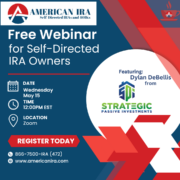Questions to Ask Yourself Before Selecting a Self-Directed IRA
If you’ve heard of self-directing an IRA before, it means that you’re probably aware that you can use a retirement account for all sorts of retirement assets: real estate, precious metals, tax liens, private companies, and much more. This is an attractive way to invest, because it means retirement investors can put aside a lot of money toward tax-protected accounts while investing in a wide diversity of assets. However, you might not have known that the term “Self-Directed IRA” refers to a wide range of potential investing vehicles, including:
- Traditional IRAs
- Roth IRAs
- SEP IRAs
- Self-Directed Solo 401(k)s
- SIMPLE IRAs
- HSAs, or Health Savings Accounts
- Coverdell Education Savings Accounts
Looking at that list, it’s easy to see how an investor can be intimidated by all the options. Fortunately, we’ve put together a list of questions you can use to help determine which may be right for you.
Question #1: Do you want to make tax-deductible contributions?
Perhaps the most important question out of the gate is how you want to structure your contributions. If you were to choose tax-deductible contributions—for example, those available in a Traditional IRA—you would avoid the Roth IRA. However, if you wanted to make after-tax contributions, meaning you pay off the taxes at the start, you would choose a Roth IRA. This is an important decision to make because it’s central to your approach as an investor: do you believe you will make more money in retirement than you do now, or do you believe you’re making more now than you will in retirement?
Keep in mind that you don’t necessarily have to choose either-or. For example, it’s possible to have both a Roth IRA and a Self-Directed Solo 401(k).
Question #2: What kinds of contribution limits do you want?
Another key differentiator with these accounts? What kinds of contribution limits you can handle. For beginning investors, the small limits of the Traditional IRA or Roth IRA can be plenty. But what happens if you have a higher income and want to set aside even more money for retirement? Then you might start looking into SEP IRAs and Self-Directed Solo 401(k)s to access their higher contribution limits. This changes the way you might plan for retirement. And because these accounts have variable contribution limits—that is, multiple rules for contributions rather than a “hard” set limit—you’ll likely have to consult with a tax advisor to make sense of how much money you can stow away in such an account for retirement.
Question #3: What is your business situation?
For many people, a Self-Directed IRA is simply a matter of personal preference. But if you run a small business, you know how quickly that can change. You might adopt a SIMPLE IRA for a larger business, fewer than 100 employees. To create a potential retirement benefit for this business, you’ll need to consider more characteristics of how this program will look, including what you will contribute toward the retirement accounts of employees. Because accounts like these may have rules for the consistency of those contributions from employee to employee, you might not have the same control as you would if you were a one-person business. Again, this is an issue to bring up with a tax advisor or financial advisor.
Your Self-Directed IRA can be a powerful first step on your journey to retirement. However, it’s also a responsibility that requires knowing the lay of the land. Interested in learning more about Self-Directed IRAs? Contact American IRA, LLC at 866-7500-IRA (472) for a free consultation. Download our free guides or visit us online at www.AmericanIRA.com.









